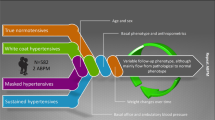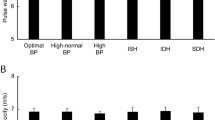Abstract
This study recruited 85 healthy children and adolescents, aged 6–18 years, from a school-based blood pressure (BP) screening study and performed office BP measurements, 24-h ambulatory blood pressure monitoring (24-h ABPM) and 24-h pulse wave analysis. Prevalence of BP phenotypes was assessed, factors that may predict hypertension (HTN) in ABPM were examined and the effect of BP phenotypes, as well as school, office, and ambulatory BP parameters on pulse wave velocity (PWV), was investigated. Forty-five (54.9%) of the children were normotensives, 8 (9.7%) were white coat hypertensives (WCH), 19 (23.2%) had masked hypertension (MH), and 10 (12.2%) had sustained HTN. Estimated adjusted marginal means for 24-h PWV were 4.79 m/s (95% CI 4.65–4.94) for sustained hypertensives, 4.72 m/s (95% CI 4.62–4.82) for MH, 4.38 m/s (95% CI 4.23–4.54) for WCH, and 4.33 m/s (95% CI 4.26–4.40) for normotensives (sustained hypertensives versus normotensives and WCH, p < 0.001, MH versus normotensives and WCH, p < 0.005). Neither body mass index (BMI) z-score nor school systolic BP (SBP) z-score could predict HTN by ABPM. Office SBP z-score was associated with 1.74 times increased odds ratio to have HTN in ABPM. Sustained HTN and MH were independent predictors of 24-h PWV after adjustment for age, sex, and BMI z-score. In conclusion, arterial stiffness in children and adolescents was assessed by 24-h PWV associates with mean ambulatory BP. Both school and office BP measurements could not predict HTN in ABPM or increasing PWV. HTN in ABPM was independently associated with the risk of higher PWV compared with normotensive and WCH phenotype.
This is a preview of subscription content, access via your institution
Access options
Subscribe to this journal
Receive 12 digital issues and online access to articles
$119.00 per year
only $9.92 per issue
Buy this article
- Purchase on Springer Link
- Instant access to full article PDF
Prices may be subject to local taxes which are calculated during checkout

Similar content being viewed by others
Data availability
The datasets generated and analyzed during the current study are available from the corresponding author on reasonable request.
References
Mozaffarian D, Benjamin EJ, Go AS, Arnett DK, Blaha MJ, Cushman M, et al. Heart Disease and Stroke Statistics—2016 update. Circulation. 2016;133:38–360.
Lurbe E, Agabiti-Rosei E, Cruickshank JK, Dominiczak A, Erdine S, Hirth A, et al. 2016 European Society of Hypertension Guidelines for themanagement of high blood pressure in children and adolescents. J Hypertens. 2016;34:1887–920.
Muntner P, Shimbo D, Carey RM, Charleston JB, Gaillard T, Misra S, et al. Measurement of blood pressure in humans: a scientific statement from the American Heart Association. Hypertension. 2019;73:35–66.
Patel SS, Daniels SR. Ambulatory blood pressure monitoring in pediatrics. Curr Hypertens Rep. 2019;21:71.
Stabouli S, Kotsis V, Toumanidis S, Papamichael C, Constantopoulos A, Zakopoulos N. White-coat and masked hypertension in children: association with target-organ damage. Pediatr Nephrol. 2005;20:1151–5.
Iturzaeta A, Pompozzi L, Casas Rey C, Passarelli I, Torres F. Prevalence of masked hypertension among children with risk factors for arterial hypertension. Arch Argent Pediatr. 2018;116:328–32.
Lurbe E, Torro I, Alvarez V, Nawrot T, Paya R, Redon J, et al. Prevalence, persistence, and clinical significance of masked hypertension in youth. Hypertension. 2005;45:493–8.
Mitsnefes M, Flynn J, Cohn S, Samuels J, Blydt-Hansen T, Saland J, et al. Masked hypertension associates with left ventricular hypertrophy in children with CKD. J Am Soc Nephrol. 2010;21:137–44.
Kotsis V, Stabouli S, Toumanidis S, Papamichael C, Lekakis J, Germanidis G. et al. Target organ damage in “white coat hypertension” and “masked hypertension”. Am J Hypertens. 2008;21:393–9.
Lithovius R, Gordin D, Forsblom C, Saraheimo M, Harjutsalo V, Groop P-H, et al. Ambulatory blood pressure and arterial stiffness in individuals with type 1 diabetes. Diabetologia. 2018;61:1935–45.
Luo X-X, Zhu Y, Sun Y, Ge Q, Su J, So H-K, et al. Does masked hypertension cause early left ventricular impairment in youth? Front Pediatr. 2018;6:167.
Stabouli S, Papakatsika S, Kotronis G, Papadopoulou-Legbelou K, Rizos Z, Kotsis V. Arterial stiffness and SBP variability in children and adolescents. J Hypertens. 2015;33:88–95.
Palla M, Saber H, Konda S, Briasoulis A. Masked hypertension and cardiovascular outcomes: an updated systematic review and meta-analysis. Integr Blood Press Control. 2018;11:11–24.
Cohen JB, Lotito MJ, Trivedi UK, Denker MG, Cohen DL, Townsend RR. Cardiovascular events and mortality in white coat hypertension: a systematic review and meta-analysis. Ann Intern Med. 2019;170:853–62.
Krmar RT. White-coat hypertension from a paediatric perspective. Acta Paediatr. 2019;108:44–9.
Niiranen TJ, Kalesan B, Larson MG, Hamburg NM, Benjamin EJ, Mitchell GF, et al. Aortic-brachial arterial stiffness gradient and cardiovascular risk in the community: the Framingham heart study. Hypertension. 2017;69:1022–8.
Urbina EM, Williams RV, Alpert BS, Collins RT, Daniels SR, Hayman L, et al. Noninvasive assessment of subclinical atherosclerosis in children and adolescents. Hypertension. 2009;54:919–50.
Van Bortel LM, Laurent S, Boutouyrie P, Chowienczyk P, Cruickshank JK, De Backer T, et al. Expert consensus document on the measurement of aortic stiffness in daily practice using carotid-femoral pulse wave velocity. J Hypertens. 2012;30:445–8.
Skrzypczyk P, Pańczyk-Tomaszewska M. Methods to evaluate arterial structure and function in children—state-of-the art knowledge. Adv Med Sci. 2017;62:280–94.
Nika T, Stabouli S, Kollios K, Papadopoulou-Legbelou K, Printza N, Antza C, et al. Obesity and season as determinants of high blood pressure in a school-based screening study. J Hum Hypertens. 2019;33:277–85.
Cole TJ, Lobstein T. Extended international (IOTF) body mass index cut-offs for thinness, overweight and obesity. Pediatr Obes. 2012;7:284–94.
Wühl E, Witte K, Soergel M, Mehls O, Schaefer F, German Working Group on Pediatric Hypertension. Distribution of 24-h ambulatory blood pressure in children: normalized reference values and role of body dimensions. J Hypertens. 2002;20:1995–2007.
Wassertheurer S, Kropf J, Weber T, van der Giet M, Baulmann J, Ammer M, et al. A new oscillometric method for pulse wave analysis: comparison with a common tonometric method. J Hum Hypertens. 2010;24:498–504.
Luzardo L, Lujambio I, Sottolano M, da Rosa A, Thijs L, Noboa O, et al. 24-h ambulatory recording of aortic pulse wave velocity and central systolic augmentation: a feasibility study. Hypertens Res. 2012;35:980–7.
Williams B, Mancia G, Spiering W, Agabiti Rosei E, Azizi M, Burnier M, et al. Practice guidelines for the management of arterial hypertension of the European Society of Hypertension (ESH) and the European Society of Cardiology (ESC). Blood Press. 2018;2018:314–40.
Panchangam C, Merrill ED, Raghuveer G. Utility of arterial stiffness assessment in children. Cardiol Young. 2018;28:362–76.
Kotsis V, Stabouli S, Karafillis I, Papakatsika S, Rizos Z, Miyakis S, et al. Arterial stiffness and 24 h ambulatory blood pressure monitoring in young healthy volunteers: the early vascular ageing Aristotle University Thessaloniki Study (EVA–ARIS Study). Atherosclerosis. 2011;219:194–9.
Lurbe E, Torro I, Garcia-Vicent C, Alvarez J, Fernández-Fornoso JA, Redon J. Blood pressure and obesity exert independent influences on pulse wave velocity in youth. Hypertension. 2012;60:550–5.
Fujita H, Matsuoka S, Awazu M. White-coat and reverse white-coat effects correlate with 24-h pulse pressure and systolic blood pressure variability in children and young adults. Pediatr Cardiol. 2016;37:345–52.
Skrzypczyk P, Mizerska-Wasiak M, Jerszow B, Ruszczykowski P, Pańczyk-Tomaszewska M. Ambulatory arterial stiffness index, blood pressure variability, and nocturnal blood pressure dip in children with IgA and Henoch-Schönlein nephropathy. Clin Nephrol. 2017;87:301–9.
Elmenhorst J, Hulpke-Wette M, Barta C, Dalla Pozza R, Springer S, Oberhoffer R. Percentiles for central blood pressure and pulse wave velocity in children and adolescents recorded with an oscillometric device. Atherosclerosis. 2015;238:9–16.
Zinoveev A, Castro JM, García-Espinosa V, Marin M, Chiesa P, Bia D, et al. Aortic pressure and forward and backward wave components in children, adolescents and young-adults: agreement between brachial oscillometry, radial and carotid tonometry data and analysis of factors associated with their differences. PLoS ONE. 2019;14:e0226709.
Johnson PK, Ferguson MA, Zachariah JP. In-clinic clood pressure prediction of normal ambulatory blood pressure monitoring in pediatric hypertension referrals. Congenit Heart Dis. 2016;11:309–14.
Mitsnefes MM, Pierce C, Flynn J, Samuels J, Dionne J, Furth S, et al. Can office blood pressure readings predict masked hypertension? Pediatr Nephrol. 2016;31:163–6.
Antza C, Doundoulakis I. Masked hypertensives: a disguised arterial stiffness population. J Clin Hypertens. 2019;21:1473–80.
Dolan E, James K. Current approach to masked hypertension: from diagnosis to clinical management. Clin Exp Pharm Physiol. 2017;44:1272–8.
Author information
Authors and Affiliations
Contributions
KK and TN: performed data collection, drafted the initial manuscript, revised and approved the final version; KC and CA: analyzed the data and approved the final version; VK and SS: designed the study and edited, revised and approved the final version.
Corresponding author
Ethics declarations
Conflict of interest
The authors declare that they have no conflict of interest.
Ethical approval
All procedures in the study were in accordance with the ethical standards of the Greek Ministry of National Education, the National Educational Institute, and the Ethics Committee of Aristotle University of Thessaloniki, which approved the study protocol (65104/Γ7/15-05-2013).
Informed consent
Informed consent was obtained from all individual participants included in the study and their parents or legal guardians.
Additional information
Publisher’s note Springer Nature remains neutral with regard to jurisdictional claims in published maps and institutional affiliations.
Supplementary information
Rights and permissions
About this article
Cite this article
Kollios, K., Nika, T., Kotsis, V. et al. Arterial stiffness in children and adolescents with masked and sustained hypertension. J Hum Hypertens 35, 85–93 (2021). https://doi.org/10.1038/s41371-020-0318-4
Received:
Revised:
Accepted:
Published:
Issue Date:
DOI: https://doi.org/10.1038/s41371-020-0318-4
This article is cited by
-
Masked Hypertension in Healthy Children and Adolescents: Who Should Be Screened?
Current Hypertension Reports (2023)
-
Blood pressure and glomerular filtration rate in youth with tuberous sclerosis complex
European Journal of Pediatrics (2022)
-
Ambulatory hemodynamic patterns, obesity, and pulse wave velocity in children and adolescents
Pediatric Nephrology (2020)



